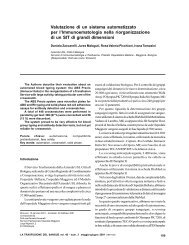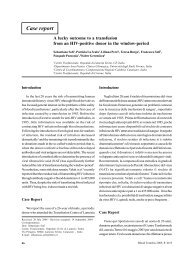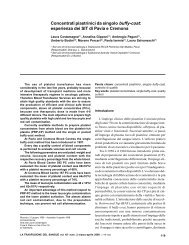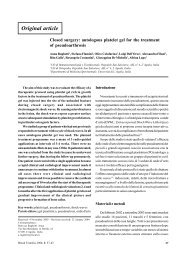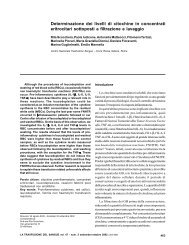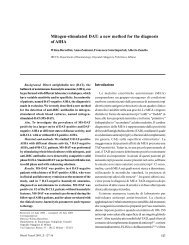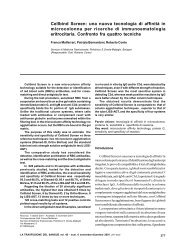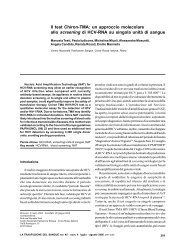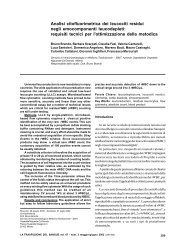Mathematics and transfusion medicine - Blood Transfusion
Mathematics and transfusion medicine - Blood Transfusion
Mathematics and transfusion medicine - Blood Transfusion
Create successful ePaper yourself
Turn your PDF publications into a flip-book with our unique Google optimized e-Paper software.
Liumbruno GM et al.In Italy, in the 5 years from 2001-2005, the clinical use offresh-frozen plasma (FFP) has tended to increase, despite2% reductions in 2002 <strong>and</strong> in 2005 compared to theconsumption in the respective preceding years, 2001 <strong>and</strong>2004. In fact, the consumption of FFP increased from 146,844L in 2001 to 153,493 L in 2005 1,7-10 .In 2002, the Tuscany Regional <strong>Blood</strong> <strong>Transfusion</strong> CoordinatingCentre (RBTCC) for <strong>transfusion</strong> services foundthat the use of FFP in the Region clearly contrasted withthe national trend; indeed, that year, the use of FFP, reachedits peak of 10,625 L (equivalent to about 3L/1,000 residents/year), with a increase of 4% with respect to 2001. Therefore,in 2003, the RBTCC, in the context of a regionalbenchmarking project lasting several years, that was aimedat continuous improvement of quality <strong>and</strong> self-sufficiencyof the Tuscan <strong>transfusion</strong> system, introduced a systematicaudit of the appropriateness of the clinical use of FFP inthe hospitals making up the regional <strong>transfusion</strong> network.Inappropriate <strong>transfusion</strong> therapy with FFP is probablyone of the main avoidable risks for patients <strong>and</strong> it is knownthat guidelines are not, per se, able to influence clinicalpractice 11,12 , because without the help of other instruments,such as auditing <strong>and</strong> educational interventions, they maynot be able to reach a level of diffusion <strong>and</strong> acceptancesuch as to be able to direct clinical practice towards therecommended behaviours.There is, however, evidence showing that clinicalauditing is an educational <strong>and</strong> behavioural strategy that iseffective in altering the level of inappropriate <strong>transfusion</strong>treatment <strong>and</strong> is able to contribute to self-sufficiency inblood products, to a reduction in health care costs <strong>and</strong> tothe delivery of better health care 13 .The aim of this study was to verify the impact of anauditing process on the appropriateness of the clinical useof FFP <strong>and</strong> to classify the main causes of the inappropriateuse of this product within the regional <strong>transfusion</strong> network.Materials <strong>and</strong> methodsThe <strong>transfusion</strong> system of the Region of Tuscany isspread throughout the region <strong>and</strong> comprises 15 Servicesof Immunohaematology <strong>and</strong> <strong>Transfusion</strong> Medicine (SIMT)<strong>and</strong> 25 depending on them 14 ; the Tuscan <strong>transfusion</strong>network is incorporated in regional hospitals, managed by12 Health Care Companies <strong>and</strong> by 4 University HospitalCompanies, which deliver health care services to apopulation of about 3,600,000 people.The study was co-ordinated by the RBTCC <strong>and</strong> carriedout over a period of 3 years, that is, the second semestersof 2003 <strong>and</strong> 2004 <strong>and</strong> throughout 2005; in this period all theregional <strong>transfusion</strong> structures audited the requestsreceived for FFP <strong>and</strong>, at the same time, undertook twocomplementary actions: updating their guidelines <strong>and</strong>involving the Hospital <strong>Transfusion</strong> Committees (ComitatiOspedalieri per il Buon Uso del Sangue, COBUS) in theevaluation of the outcome of the audit <strong>and</strong> in theconsequent implications for local policy <strong>and</strong> education ofclinicians.The audit was conducted by manual review of<strong>transfusion</strong> requests by medical staff of the SIMT <strong>and</strong> the<strong>Transfusion</strong> Sections. Each <strong>transfusion</strong> structure was askedfor the following data for each year: a) method of carryingout the appropriateness audit (retrospective orprospective) of the FFP <strong>transfusion</strong> requests received; b)total number of requests for FFP received; c) number ofFFP requests audited; d) classification of the requests, onthe basis of literature data <strong>and</strong> specific hospital guidelines,into: 1) appropriate; 2) inappropriate <strong>and</strong>, from 2004, 3) intoa grey zone, with the aim of dividing the definitelyinappropriate requests from those that were potentiallyinappropriate; e) classification of the inappropriaterequests, from July 2004, according to the following,predefined, homogeneous regional criteria: 1) haemorrhagein a surgical context with PT <strong>and</strong>/or PTT not available; 2)haemorrhage in a non-surgical context with PT <strong>and</strong>/or PTTnot available; 3) haemorrhage with PT <strong>and</strong>/or PTT normal;4) prophylaxis of haemorrhagic events with PT <strong>and</strong>/or PTTnormal or not performed; 5) prophylaxis of haemorrhagicevents in the presence of altered PT <strong>and</strong>/or PTT; 6)hypoalbuminaemia <strong>and</strong>/or nutritional purposes; 7) requestsbased on predefined formulas; 8) concomitance of morethan one of the preceding causes of inappropriateness; 9)other causes.The data collected by the SIMT <strong>and</strong> the <strong>Transfusion</strong>Sections were subsequently sent at regular intervals to theRBTCC, which processed them, <strong>and</strong> reported them togetherwith information on the regional production <strong>and</strong>consumption of FFP from 2002 to 2005; furthermore, theclinical use of FFP from 2002 to 2005 was also comparedwith the consumption of red blood cells (RBCs), a parameterused by the RBTCC as a regional indicator of the intensityof health care activities.The statistical analysis (Student's t test) was carriedout with GraphPad InStat software (version 3.00, GraphPadSoftware, San Diego, CA – USA).ResultsData were received from all 40 regional <strong>transfusion</strong>structures <strong>and</strong> analysed. Each hospital revised its own76<strong>Blood</strong> Transfus 2007; 5: 75-84 DOI 10.2450/2007.0015-07075-84_Liumbruno.p65 7605/07/2007, 11.01



